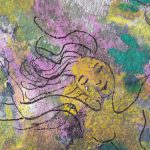Greg Shand speaks of his experiences of immersing himself in an Indian ashram and finds it has a profound and positive effect.
This story was recently published in the New Zealand Listener. Greg Shand is a former journalist and public relations consultant based in Auckland.
Instead of your usual early morning walk, run or gym session to get your day going, try this hour-long workout: 10 minutes of blowing as hard as you can through your nose, then 10 minutes feigning total madness, followed by another 10 minutes jumping up and down on the spot with your arms held high, shouting the mantra “hoo” as you land. When commanded to “stop!”, freeze your body however you land, making not the slightest movement for 15 minutes. For the last 15 minutes, relax, dance and sway to Indian music in easy celebration.Freezing like a sculpture after half an hour of such activity makes you extraordinarily sensitive to your physical reactions and emotions. It’s much more than your heart beating furiously; you sense the blood coursing through your veins, and feelings seem to well up from all over your body. The dancing that follows is magical, as though you’re in a trance.
[portfolio_slideshow]
I know this because I did this every morning for most of a recent 16-day stretch. It sets you up for a highly aware and alert – but also tranquil – day. It is called “dynamic meditation”, as practised in one of India’s best-known spiritual and meditation ashrams, the Osho international meditation commune in the city of Pune, near Mumbai.
Osho has become one of India’s most popular tourist destinations, attracting some 200,000 visitors from all over the world each year. Most are drawn by hopes that after a few weeks or months, they will emerge as more rounded and balanced individuals, and thus better equipped to deal with the modern-day stresses of the outside world.
Osho – or, as he was formerly known, Bhagwan Shree Rajneesh – was one of the subcontinent’s most colourful and controversial mystics before his death in 1990 at age 58. He has since been lauded by Indian media, along with figures like Gautama Buddha and Mahatma Gandhi, as one of the 10 people who have most changed India’s destiny, in Osho’s case by “liberating the minds of future generations from the shackles of religiosity and conformism.”
According to Osho, the major barrier to this search for self-discovery is the egotistical mind that rules and distracts most people, and especially Westerners, with its constant preoccupation with personal advancement. Stripped bare, this is really all about ambition, wealth, greed and lust. Such cravings and strivings, he said, can only lead to a state of permanent frustration and dissatisfaction with the relatively ordinary lives most of us are predestined to lead. It also explains why so many people, sensing they are adrift in the materialistic superficiality of modern-day life and its incessant hype, remain deeply dissatisfied with their fates.
The challenge I confronted during my stay is the quest for “no mind”, or a state of meditation that tries to at least contain – and, better still, silence – the mind, albeit temporarily. This, Osho said, opens the path inwards, so you can pay undivided attention and give expression to the true feelings and emotions of your inner “god” or being – which will reveal the true, inherent personalities we are each born with in the interconnected world of Buddhism.
I thought I knew a bit about this when I arrived at the rather-grander-than-I-imagined black marble entrance to the Osho commune after six weeks of travelling in India. I was familiar with the writings of Eckhart Tolle, the best-selling author of The Power of Now, which also shares the Osho philosophy: to lead happy lives, people have to learn to live in the present, and not waste time and energy dwelling on the past, or being constantly preoccupied with trying to imagine a better future. Tolle’s teachings are also based on techniques to liberate people from the “enslavement of the mind”, and go beyond any particular religion or established doctrine.
So I entered the ashram thinking I should be able to cope with whatever lay in store. But I was not prepared for the extraordinary reality. Once inside the ashram’s high walls in the affluent suburb of Koregaon Park, you discover you are in a five-star resort, with guesthouses, restaurants, cafes, pools, jacuzzis, beauty and massage parlours, plus dozens of self-contained meditation centres, all set in 11 sprawling hectares of lushly manicured gardens and parks.
But the centrepiece is the “Buddha Hall”, a pyramid that serves as the commune’s main gathering place and meditation centre, reputedly the largest in the world.
Day one was an eye-opener: as I traipsed along in my new full-length maroon robe, along with hundreds of other maroon-garbed meditators, heading towards the hulking black pyramid towering above us in the early morning darkness, it seemed like a surreal scene from the movie Eyes Wide Shut.
On the first two mornings of “dynamic meditations”, I struggled to overcome my inhibitions and self-consciousness. “Is everyone really going mad?” I would ask myself as I broke the rules and peered around me. But once I let it all scream out, the 6.00am sessions soon became a staple of my day, such was the natural high I enjoyed as I emerged into the daylight.
Other set-piece “dynamic meditations” followed, including an hour-long session in the late afternoon consisting of 15 minutes of full-body shaking, 15 minutes of full-on dancing and 30 minutes of silent meditation. Later, white robes replaced maroon as disciples attended the popular evening meditations, which involved more dancing, followed by a video lecture from the long-dead guru himself. Osho encourages you to bring all your life’s baggage with you. The group meditations and a wide range of intense smaller-group therapies and courses are all designed to make you let go and express your feelings and emotions, good or bad, in a non-judgmental environment.
During my short stay, I did some extraordinary stuff I had never contemplated: like spending 72 hours locked away with 12 other people, eyeballing each other and repeatedly asking in rotating pairs: “Tell me, who is in?” I also did a day-long “breath energy” course, which involved instruction on various intense breathing exercises. That night, I again felt euphoric.
I also did a day-long “fast track to yourself” awareness course and the next day an “emotional freedom” course. We spent a lot of time shouting out our emotions and banging pillows on walls, when we weren’t quietly consoling, comforting and hugging each other. Some spent the whole day crying off and on, such were their long-bottled-up emotions.
And I only really had an entrée experience to the world of Osho. The most recommended course is 21 days long, comprising three hours laughing every day for a week, three hours of weeping each day for a second week and three hours a day of silent meditation in the final week.
No doubt many people will find this account of my experience difficult to relate to. Cynics will be dismissive. But it had a profound and positive effect on me – my only regret is that I didn’t stay longer. I’ll leave the final word to one of Osho’s spiritual successors: “Few Kiwis come here. I don’t know why, whether we are off the radar or just too far away. But your country would provide an amazing setting for a meditation commune like this. The trouble is, my impression is most of you Kiwis live in a box.”




Comments are closed.